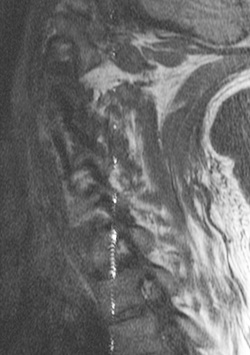|
Zipper-like bands of spurious signal passing through the image result from a variety of causes, so no single maneuver may correct them all. The most common form of zipper artifact passes through the center of the image and is oriented in the phase-encode direction. This type of zipper artifact results from varying transmitter leakage ("feed-through") picked up by the receiver system. Perhaps the most common origin of this RF noise is an extraneous source that reaches the receiver coil because the door of the RF shielded scanner room has not been fully closed or its seal is defective. A second common cause is RF emission from anesthesia monitoring equipment (e.g., pulse oximeters) used within the scanner room.
Zipper-like artifacts oriented in the frequency-encode direction are usually caused by stimulated echoes from imperfect slice-selection profiles or improper RF-transmitter adjustments. Increasing interslice gap may minimize them, but a call to the service engineer is usually in order. |
The annefact (cusp) artifact closely resembles the zipper artifact in that it is a featherlike ribbon of bright signal smeared through the center of the image in the phase-encode direction. It arises from stimulated echoes picked up outside the FOV by distant array coils that have not been properly deactivated. This artifact is a wrap-around artifact due to gradient non-linearity
coupled with a spatially varying main magnetic field near the end of the magnet bore. Annefact (cusp) artifacts are most commonly seen on coronal or sagittal FSE images of the spine or pelvis. Occasionally they may be reduced to a single cluster of points near the middle of the image and referred to as a star artifact. |
Advanced Discussion (show/hide)»
No supplementary material yet. Check back soon.
References
Artasona LM. Annefact artifact in MRI. Blog at El Baul Radiologicó 16 Mar 2015, accessble at this link in Spanish.
Graves MJ, Mitchell DG. Body MRI artifacts in clinical practice: a physicist's and radiologist's perspective. J Magn Reson Imaging 2013; 38:269-287.
Heiland S. From A as in aliasing to Z as in zipper: artifacts in MRI. Clin Neuroradiol 2008; 1:25-36.
Larkman DJ, Herlihy AH, Coutts GA, Hajnal JV. Elimination of magnetic field foldover artifacts in MR images. J Magn Reson Imaging 2000; 12:795-797.
Rangawala N, Zhou XJ. Reduction of fast spin echo cusp artifact using a slice-tilting gradient. Magn Reson Med 2010;64:220-228.
Zhuo J, Gullapalli RP. AAPM/RSNA physics tutorial for residents. MR artifacts, safety, and quality control. Radiographics 2006;26:275-297.
Artasona LM. Annefact artifact in MRI. Blog at El Baul Radiologicó 16 Mar 2015, accessble at this link in Spanish.
Graves MJ, Mitchell DG. Body MRI artifacts in clinical practice: a physicist's and radiologist's perspective. J Magn Reson Imaging 2013; 38:269-287.
Heiland S. From A as in aliasing to Z as in zipper: artifacts in MRI. Clin Neuroradiol 2008; 1:25-36.
Larkman DJ, Herlihy AH, Coutts GA, Hajnal JV. Elimination of magnetic field foldover artifacts in MR images. J Magn Reson Imaging 2000; 12:795-797.
Rangawala N, Zhou XJ. Reduction of fast spin echo cusp artifact using a slice-tilting gradient. Magn Reson Med 2010;64:220-228.
Zhuo J, Gullapalli RP. AAPM/RSNA physics tutorial for residents. MR artifacts, safety, and quality control. Radiographics 2006;26:275-297.
Related Questions
Are there any other data- or hardware-related artifacts that we should be aware of?
Are there any other data- or hardware-related artifacts that we should be aware of?



